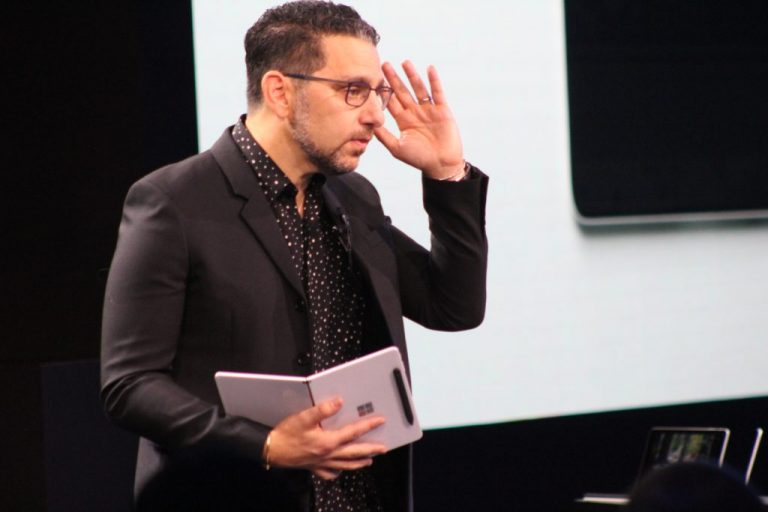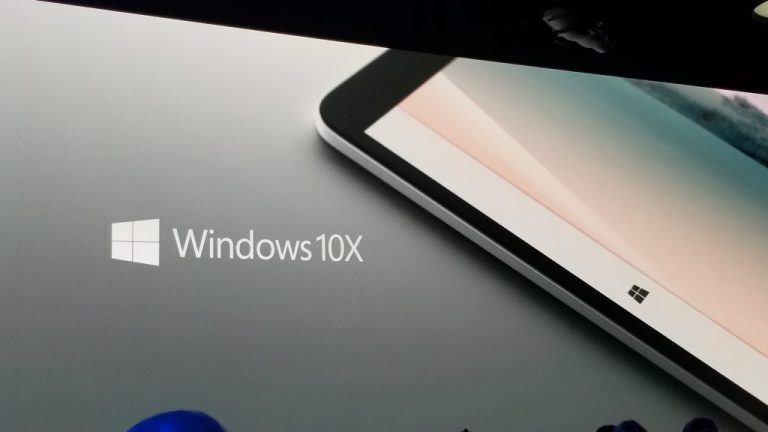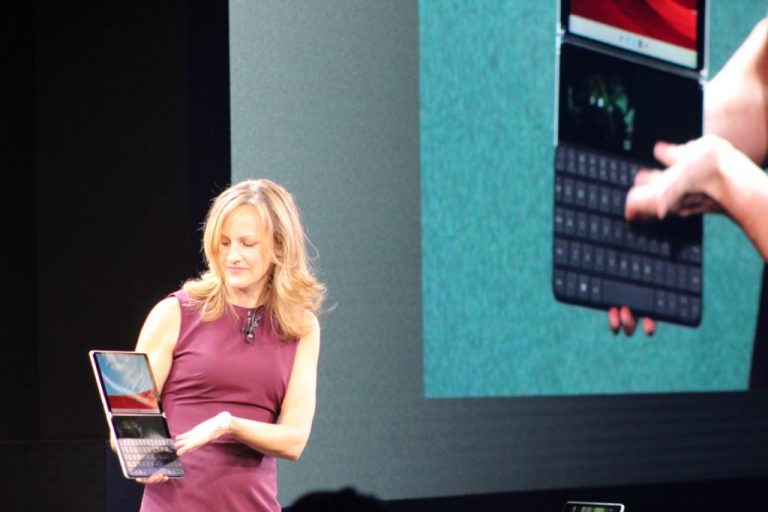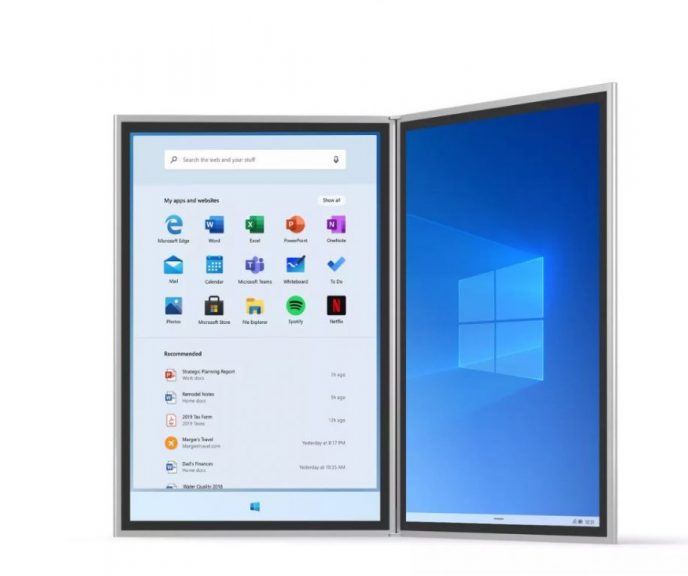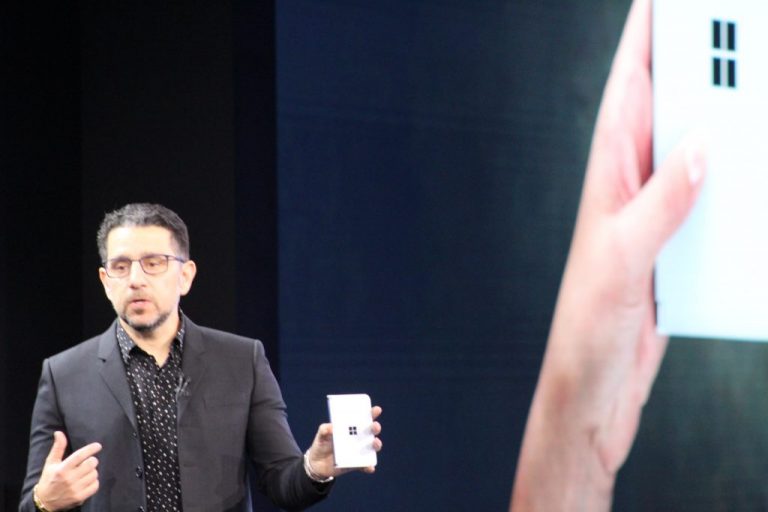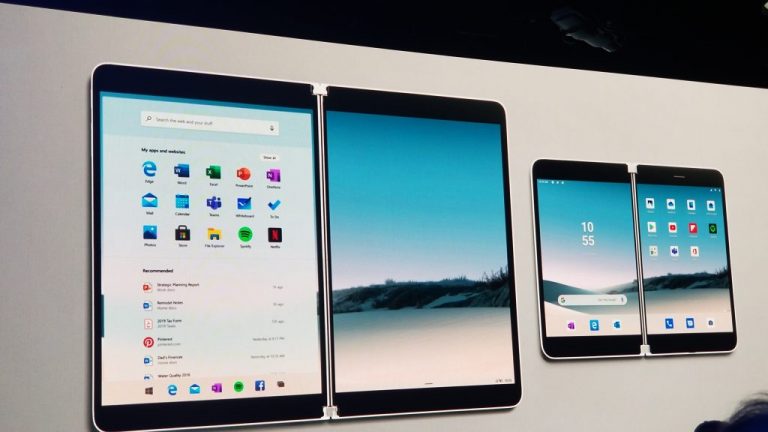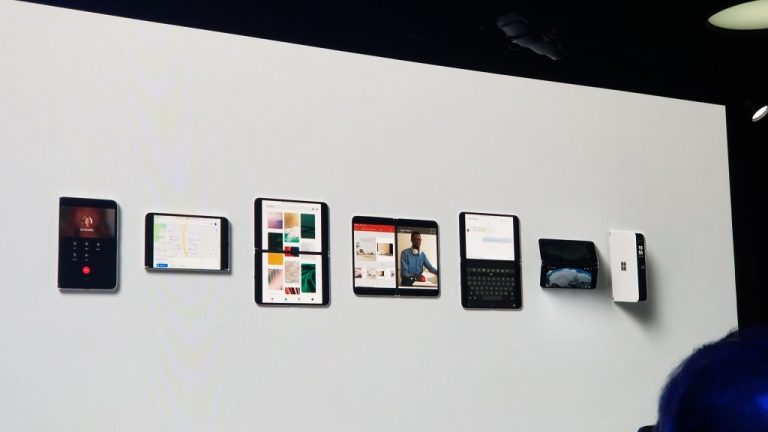We get up close with Surface Neo and Duo, what you need to know and why it matters
7 min. read
Published on
Read our disclosure page to find out how can you help Windows Report sustain the editorial team Read more

Heading into the future, Microsoft is taking a big bet on a new trend we’ve seen emerge with phone and even some laptop makers (like Lenovo) this year — dual-screen devices.
There have been plenty of patents, leaks, and more relating to Microsoft’s work in this area, but yesterday, at the October 2 Surface event, the company finally came out and made everything public. Big Redmond showcased a working prototype of a dual-screen Windows 10 PC known as Surface Neo, and shocked the world with a dual-screen Android-powered phone that is known as Surface Duo.
Microsoft kept the two new devices pretty much under lock and key, but we were able to get close, anyway. Here’s everything we currently know about the two devices, and why it matters.
Surface Neo
We’re starting first with Surface Neo. The device will be shipping first to developers within the next couple of months. Later, it will then come to consumers next year, around holiday 2020. There are also a few other important things to note.
First off, Neo features two 9.1 inch screens, that when folded together add up to 13 inches. Apparently, it is also the thinnest Gorilla Glass LCD screen ever created. Next, the weight is about 654 grams. Judging from the photos of the prototype that we took, it also sports a nicely hidden polished 360-degree hinge between the screens.
You’ll also notice the detachable magnetic pen on the back of the screen, as seen in this photo from the keynote that we took of Panos holding Neo. Finally, under the hood, Neo is powered by Intel Lakefield processors, an as-yet unreleased hybrid processor for dual-screen devices.
Why does it matter? Because of Windows 10 X
What matters most about Neo is not the hardware. Instead, it is the fact that it is running Windows 10 X, a flavor of Windows Core OS just for dual-screen devices. Not only will this power Neo, but also a new wave of future devices from HP, Dell, and ASUS. Much like it did when pioneering the 2-in-1 form factor with the Surface Pro, Microsoft is betting big on dual-screen devices, and actually has the software and partners for it, or so we hope.
There’s not much we know about Windows 10 X, but we were shown on stage at the Surface event how two apps (Mail and Edge) could run side by side on the two screens, and how an app can cross the two screens with a “spanning” feature. We also were shown that apps could launch on one screen, and pushed to the other by dragging around the hinge. It was also confirmed that all Windows apps and the Office apps will be supported in Windows 10 X, with developers not having to worry about changing the coding for apps, although it’s less clear exactly how the “spanning” feature will work.
Elsewhere, we were shown the “Wonderbar” feature of Windows 10 X. Somewhat like the TouchBar on the MacBook Pro, this small half-portion of the bottom screen appears when you attach a physical keyboard to the bottom of Neo. It will show emojis, a trackpad, inking options, and even work as a small screen. Presumably, if you connect a physical keyboard or third-party keyboard, the same will happen.
It’s also become apparent that Windows 10 X on Neo, and other devices, will ditch the traditional start menu. According to The Verge, the new Start menu is similar to the one we saw when a rogue Windows Insider build went public. You’ll just see a list of pinned apps, a list of recent documents, as well as a search bar, and a Start button. There are no more live tiles.
Surface Duo
Next, there’s Surface Duo. Also coming in time for Holiday 2020, this is a similar dual-screen device to Neo. However, instead of being a PC, it is meant to perhaps mark Microsoft’s return to the phone world. We especially saw this in the teaser video for Duo, where a woman pulled the device out of her bag while already working on Surface Duo, and answered a phone call. Anyway, there’s a couple of tidbits to note on this device.
To begin some specs lists, the Surface Duo sports two separate glass 5.6-inch displays, which fold out to one 8.3 inch display. It’s also 4.8 mm thin and sports the same 360-degree hinge as Neo. According to The Verge, the demo device also sports a Snapdragon 855 processor inside. Much to our surprise, it also powered by Android.
There’s also some confusion as to what cameras are on Duo, as the prototype we saw during the Surface Event only had one front-facing camera. However, MSPoweruser reports that Microsoft had two separate versions of the device. One of which is a black version that YouTuber Marques Brownlee, captured with a camera hole.
Why does it matter? Because of Android
But, why does this all matter to you, as a Microsoft fan or follower? Well, for the first time ever, a Microsoft product is not featuring a Microsoft operating system. Instead of running Windows, the Duo is powered by Android. That’s right. Microsoft is becoming an Android phone maker.
Be damned if you may, but there there is a good reason as to why. According to press interviews, Panos Panay believes that Android has the apps people want. This is something that’s part of the reason why Microsoft’s last venture into the world of phones failed. That’s you, Windows 10 Mobile.
Anyway, when Panos Panay was asked about why Android, this quote from The Verge puts it’s best.
“Because there are hundreds of thousands of apps, and you want them. And [Microsoft CEO Satya Nadella] and I talked about it, and it’s about meeting our customers where they are, where they’re going to be. I don’t think the mobile application platform’s going anywhere anytime soon.”
But, Android won’t suddenly be the big operating system for Microsoft. The other dual-screen device, Neo still runs Windows. Instead, it appears as though Android on Duo is all about giving customers choice, again, in the words of Panos via The Verge. Which is a good thing, considering the flops of Surface RT, Windows 10 S, and Windows 10 Mobile.
“You want to give customers what they want in the form factor that they’re using. We’ve learned this — let’s put the right operating system on the wrong product or the other way around. But what’s the right operating system for the form factor? And in this case, on mobile devices, Android’s the obvious choice, But anything [bigger than] that, Windows is everything”
Big steps forward for the future at Microsoft
Putting everything together, Microsoft is taking a big step forward in its history. At the same time, it also has demonstrated that it learned from the failure of its past. Bidding on the dual-screen PC and phone is a huge thing, and I think Microsoft is setting itself up for some success here.
Why? Well, though the company has the physical hardware ready for both Duo and Neo, it’s waiting for developers to test it first. Microsoft won’t be releasing an unpolished and app-less operating system as it did with Windows 10 Mobile. With Android, and Windows 10 X, it is letting the developers test the products, then release it first to consumers in all the glory.

